By Kristin Tara Horowitz, production manager and race fixer for All Out Events and the All Out Adventure Series
I’ve been putting on adventure racers for over ten years now. Short ones, long ones, and ones in between. The funny thing is, though, I rarely get a chance to race in them myself. Moreover, I’m not really a “race person.” I got into these kind of events because I am an “adventure person.”
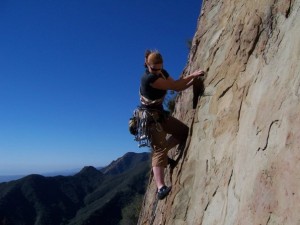
In my early 20s, I discovered rock climbing, and actually got really famous because of my “trip reports” that we’re more like, “epic reports” about climbing adventures gone wrong. I traveled all over the US and checked stuff out, wrote about it, and by doing that, I ended up having some really big adventures, good and bad. I got used to being able to pull out everything I had to rescue friends, get off the top of rocks in the dark, and even hike without food or water all day when a plan went awry. I didn’t really need a race environment to give me those experiences, but my experiences got me into helping others do it in a constructed way.
My adventures had to take a couple detours, though. I was born with extremely lax joints – and my first knee dislocation happened when I was tying my shoes in P.E. in high school. From there, my philosophy was basically ignore it and take a lot of Ibuprophen. I was on that stuff for years and years – feeling no pain, but wearing away at my knees that tended to pop out a lot. Those people who knew me into my mid twenties were pretty used to me taping the little guys up so they wouldn’t pop on hikes and climbing and doing a lot, and I mean A LOT, of weights to keep the muscles around them balanced.
Combine that lax joint thing with the fact that my build is on the heavy end, and the climbing finally caught up with me. In 2003 I took a fall because my arm popped out of its socket, and, being me, I took a LOT of Ibuprophen and went ice climbing and rock climbing the next few days, figuring it was just another little setback. It took me five years of training and training and never getting better to finally take my shoulder to the doctor and have reconstruction done on a torn tendon. I was back to adventuring in a few months – I even did our Checkpoint Challenge right after, but when we ordered our kayaks (the ones we use to rent out for adventure races) and took them out of the truck, something happened that popped my shoulder out of joint and I spent the next couple days wishing I had some lovely Percoset to dull the pain. It started happening all the time, and I was quicker to the doctor this time, and it turned out I needed a second surgery – one that would tighten up the capsule and set the shoulder a lot tighter.
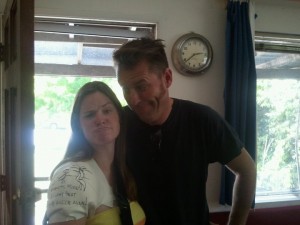
It also took a LOT longer to recover from this one. I was drinking energy drinks and feeling lethargic for most of a year, and it took a second year to finally start really getting to feel normal again. I took it easy, mellowed a lot on my climbing goals, and started taking better care of myself through diet, going to running coaching, learning to swim properly, getting acupuncture for all my ailments, and finally learning to mountain bike to fill the climbing void.
But I could feel my desire to get into the kind of situations that test you to really be waning. My shoulder was mostly good, but I was afraid to venture into the wilderness again. The thought of having the kind of epics that once made me famous was hard to swallow. I have to confess that at this point, sometimes just doing steps can hurt (the bad knees aren’t going away) and doing something like a 12-hour adventure race seemed like the kind of hurdle I should aim for to get back the mojo I’d once lost.
And so, in January, I put the call out to Facebook friends and told them I was training for the 12 hour race that took place after our own (because trying to put on a race and run one is pretty impossible). I know what it takes to succeed at our own race from watching people do it and scouting for them, and I knew it would take me the full six months to get there because I had learned that slow and steady wins the race if you want that base fitness back. I got the book The Outdoor Athlete and crafted a training program for myself.
Getting the team together was important. In the beginning I did the fantasizing about how in shape I would be in the end and how awesome that would be, but by April, my interest was waning. This was also the same time we were getting seriously into the adventure racing season and being physically able to tackle my own course seemed really far out of reach. Not being able to back out because of my teammates having already paid and committed to it (and they didn’t know each other before this – I was the cement) was what kept me going.
A week out or so I was a little nervous. One of my teammates, Wade, had just done an enduro mountain bike race and has been riding easily 4-5 times a week. He wasn’t doing the foot or kayak training, but his biking was solid. My other teammate, King Richard (who many in the AR world know from his prolific volunteering all over the world), tried out his mountain bike a few days before the race and said he was sore. Everybody knew that I was coming back from injuries and were still interested in doing it so this was not a “go for the gold” kinda thing. Wade put it really nicely, “We’re going to explore. If we happen to stay in time and on course, THEY’LL be lucky to have us.”
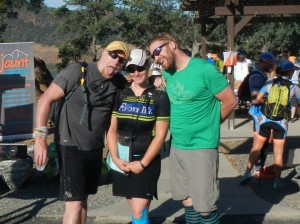
So with that, we got on our way. I went from massive trepidation to pretty neutral but psyched to be doing something with friends. Yishai (our race director) and Ryan Tarver were our “in it to win it” team but unlike me, they didn’t do any training. They both have great base fitness, though. Then there was Wade and Rich and me.
I’m super anal retentive about stuff – I want everything dialed and efficient, and I want to be the best I can be. It was really hard for me to not have everything laid out ahead of time the way we do our races, but that was not this race’s style, clearly. What do we put in the transition area
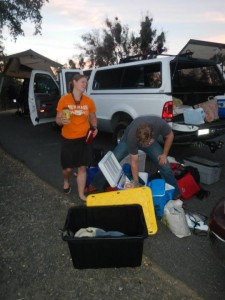
and what do we carry? How much nutrition should I plan on consuming throughout the race? Etc. I couldn’t get answers and the guys wouldn’t let me stress it too much, so they were perfect for my first 12 hour. Sometimes a girl needs to let things just unfold.
On race day, I got up with the sun – a beautiful, riotous red sunrise, and started putting on my gear. My pack was ridiculously heavy because of the water and homemade Lara bars that were the primary nutrition plan (and my jar of pears . . . that’s the good stuff for me on hot days). As team captain, I saw it like this: Wade was our bike dude. Richard was our “keep it chill dude, I’ve seen this a million times before,” and I was team mother. We had the salt pills, we had the ibuprofen, the first aid kit, zipties, and even duct tape. As a climber, I’m never without my 20′ cordelette, so that came, too. All of them (except the zipties) came in handy. It also made my pack like 20 lbs. But I’ve been doing weights, I can handle it.
Taped up the knees with kinesio tape (one side fell off during the race, grr). Taped up the shoulder. Popped an ibuprophen with a jar of cold coffee (that’s one way to start the day psyched and make sure all your plumbing is working) and was ready to get this thing done.
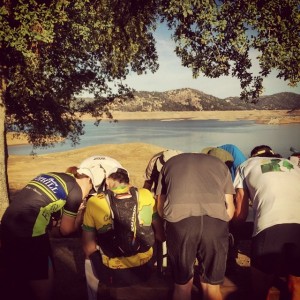
The race briefing gave me a better idea of what to expect, and rather than plotting checkpoints, we just went over to a table to copy them. I noticed that the maps had roads that weren’t on the ones we were supplied (thanks to me being the map checker for our races) and drew them in. I also drew the checkpoints and transition areas in on the park map they supplied. Both of these things were super good things to do before the race.
And so it began. Everyone started out running but I knew better – looking at the rules, there were something like 30+ checkpoints and transitions to get to compared to All Out Adventure’s 10-15 or so. Instead of being worth points, they were time penalties for skipping. An hour per one skipped on the second trek vs 30 minutes for the first, so I figured we should just get the easy ones on this first round so we had plenty of time to get the next ones.
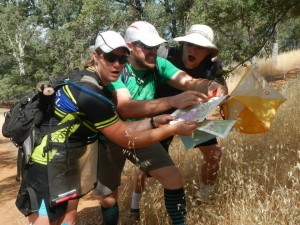
We took it very, very seriously. Wade would call out our time every hour or so while he was making sure to eat and that was really good for being on track. We only walked things, but watching people run past us only to walk and fall behind the entire day reinforced that saving energy at this point was always a good idea. I was feeling pretty amazing, no pain, nothing.
The next stop was the first kayak leg. The guys had to port our boats down the almost-empty lake and we had to wade through the mud to get in (pretty much everyone was like – it’s a Mud Run, too! And all of us tried to be clean but eventually gave up and went with it by the end).
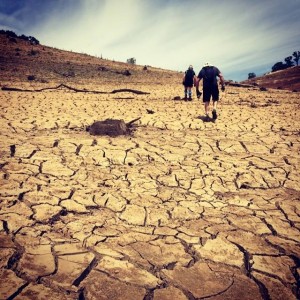
We experimented with towing and not towing and it took a dang long time – on every leg of the kayak we lost a lot of time doing this, so moral of the story is pay more attention to the kayaking leg than anything else with regard to logistics – I’m sure we lost at least an hour to all the futzing over the course of the day. We were supposed to be a team of four, but one dropped out and that left us with two tandem kayaks – making it inefficient for the solo and that was a bummer too, but as Wade kept saying, “DFL – DeadEffing Last is better than DNF – Did Not Finish.”
I did all of the navigation for the team – I’m not super awesome with a compass, but years of putzing around the hills near my house and in the sierra unattended have made me good at finding my way by intuition and experience. I think I might be pretty worthless at nav in treed places like the Eastern US and Costa Rica, but I have sparse landscapes dialed. I felt really good about how we navigated everything, passing more experienced teams making mistakes.
The bike was way too short, but fun. At first we were going to go get the harder access points and roll downhill, and the easiest way to do this was by road, so that’s what we started doing. As I’m finishing the big climb up the road, the race director drives up and says, “Roads are off limits. If I see you doing it, you’ll DNF.” This was NOT in the rules anywhere so I am more than a little miffed (we also used roads strategically on the trek portion), especially since I knew other teams in the lead had been doing so and had to tell everyone we saw on the way down the same thing. We headed back down and decided to get the easier bike checkpoints.
 By this time, it was dead-heat of the day and this was also Richard’s weakest adventure race skill. The course was incredibly easy – what I thought mountain biking was like before I got into it. In San Luis Obispo, everything is climbs and rocks, but this was relatively flat, rolling courses – nothing technical. I barely pedalled and never got my heart rate up – and it was AWESOME. My writing down the additional roads came in handy for this because we ran into a lot of people looking for a checkpoint that wasn’t obvious despite us being told to stay on trail and helped them get it. Unfortunately, King Richard got some heat exhaustion and cramps so we lost probably an hour there making sure he was recovering well. We still felt good about it. By the end of the bike, we still had six hours left (according to the email we got that said the course would close at 10 pm)
By this time, it was dead-heat of the day and this was also Richard’s weakest adventure race skill. The course was incredibly easy – what I thought mountain biking was like before I got into it. In San Luis Obispo, everything is climbs and rocks, but this was relatively flat, rolling courses – nothing technical. I barely pedalled and never got my heart rate up – and it was AWESOME. My writing down the additional roads came in handy for this because we ran into a lot of people looking for a checkpoint that wasn’t obvious despite us being told to stay on trail and helped them get it. Unfortunately, King Richard got some heat exhaustion and cramps so we lost probably an hour there making sure he was recovering well. We still felt good about it. By the end of the bike, we still had six hours left (according to the email we got that said the course would close at 10 pm)
We kayaked back and checked in at the transition area, taking time to let the guys recover and for me to down my pears and pear juice. By this point, I was suddenly feeling totally on fire. My body was operating at 100% efficiency, maybe for the first time in a long time. Where both of them were starting to really feel the effects of the heat and the day, something opposite was happening to me. I was really expecting to get tired and frustrated and want to give up, but the opposite happened – the same thing that made me famous with those climbing trips. As they declined, I rose to the occasion. I was ready to save the day, or something like that. I wonder how opposite it would have been if I had been racing with people who totally outclassed me (like with my husband’s team) – this might be a mental thing.
Anyway, the RD gives us some crap about taking our time in the transition area and tells us it’s probably 2 hours out and back to get the mandatory checkpoints. At this point, it’s 6 pm. I totally think we still have until 10 pm, so all good. Maybe we’ll get some more, too.
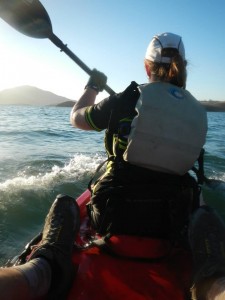
On the way out of this paddle, the wind is against us – and the kayak is very, very long. The maps weren’t continuous like I’m used to giving out at our races and we made the mistake of assuming they were – instead, the kayak was about twice as long as we expected it to be and with the inefficient boats and three-person system, it took us about an hour to get to the area we were looking for. We took our time, saving energy for the final push back and tried to make it fun with songs and jokes. Just as we were getting close, a boat pulled up and told us we had to turn around because the course was closing at 7 pm.
Race director Kristin could not stand for this one. A 12 hour race that starts at 8 pm does not close an hour early just because we’re behind and everyone else is out there already. She called in our team to the race director and confirmed that I was fine. I mean, I just talked to him – he knew we would be at least two hours out there. She tells us that we HAVE to be back by 8pm or else we’ll DNF. This, also, really irks me. And at the end of the race, too. The email said 10 pm and now it’s 8 pm? I understood that they wanted people to target that 8 pm close time, but the rules state that it’s not a hard close – it’s a time penalty. Given that we probably skipped half the checkpoints, we’re looking at our “time” being 30 hours – time penalties be damned, DLF, not DNF. This especially goes because on the bike course, we’d passed the 6 hour mark, yet all the 6 hour racers were still out there, some just heading out to checkpoints while we were returning. It gave me the impression that my strategy was just fine. Our race goes until everyone gets back and I guess I assumed this would be the same. We were playing the DFL > DNF card and now they were going to DNF us because they changed the rules. Uncool. We went on anyway. I tried really hard not to think too much about this because I was pretty mad about how this was going down.
By the time we got to the area, we’d come across a couple other teams that had been turned back and some others that were telling us that even landing the kayaks was another half hour away and that the checkpoint was an hour round trip. I’m wondering why the race director gave us bad info, but from their tone, I want to believe them. But I am also feeling all the power and charge that’s coming mystically from my usually decrepit body and I know I can at least charge up to that mandatory checkpoint, yes I can.
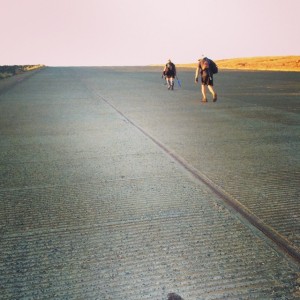
That’s when our other team happens to show up on their way back and I have a chat with them – they tell us, no, it’s pointless, go back. And so we do. We get one of the two mandatory checkpoints and turn around. The guys are exhausted portaging the boats up to the dock we landed it on, taking us precious minutes closer to this new hardline 8pm finish, but as we round the corner to see everyone they’re yelling, “30 seconds! 30 seconds!” so I start running up the hill with the paddles and seat and my guys in tow and we finish with 15 seconds to spare.
I guess I still don’t get that. Was it a DNF if we didn’t make it by 8 or a time penalty? We had to miss at least 10 other checkpoints with hour-long time penalties, so what did it matter? It did make for a fun/interesting finish. Everyone’s all celebrating but we couldn’t get the other mandatory checkpoint so I don’t know if we DNF’d or what. One team told us that they got all these checkpoints except the mandatory ones, so . . . then what?
So, I learned a lot about how other people do things in contrast to how we do them, managed to stay mellow and not anal retentive about how things had to be for me both during the race with my team and with the race itself, and, for serious, I felt like I had a complete bodily renewal. I was bouncing around at the finish, just so psyched about how amazing I felt, especially in comparison to everyone else- that I’d managed to train the right amount to not get cramps or soreness, to do the nutrition thing right and not get dehydrated or weak, and felt better than I have in a long, long time.
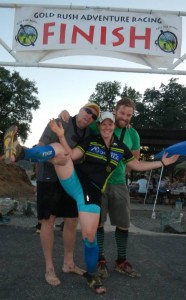
The bonus was this one guy sitting down next to me and telling me his wife was on course and had marked at how strong I was. Being not a little thing, “Strong” is the best compliment you can give me because “graceful” and “beautiful” aren’t really my attributes. It’s still two days later and I feel amazing and am ready for whatever the next thing is. I wish I could race my own race, but that won’t be. My friend was there with her boyfriend (on our other team) and told me she’d definitely be up for one, so perhaps we’ll be back, and I’ll be armed with knowing what questions need to be asked so I don’t get so damn frustrated with the race right at the end. And I also have a much better perspective of what it’s like to be a first time racer for our own events so that I’ll have those questions answered before they ask them.
Cheers to adventure racing!
